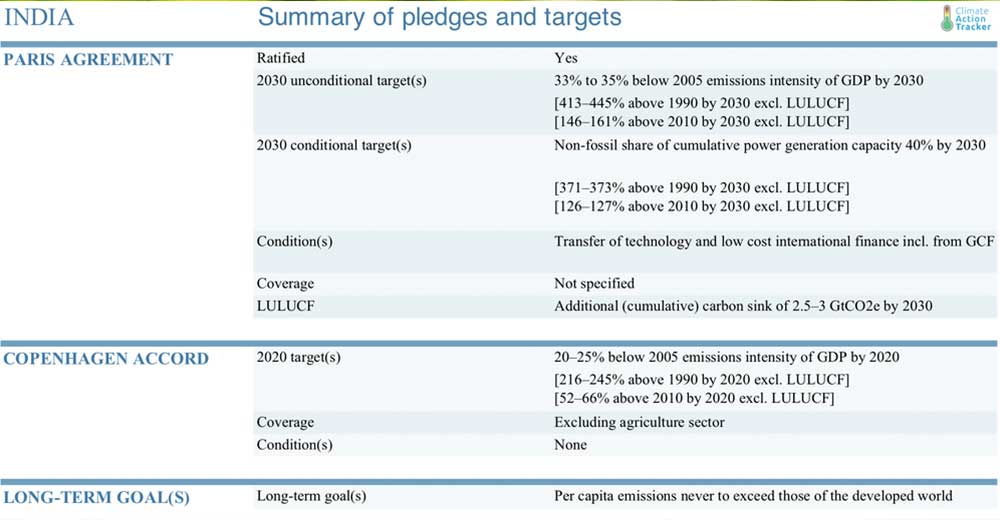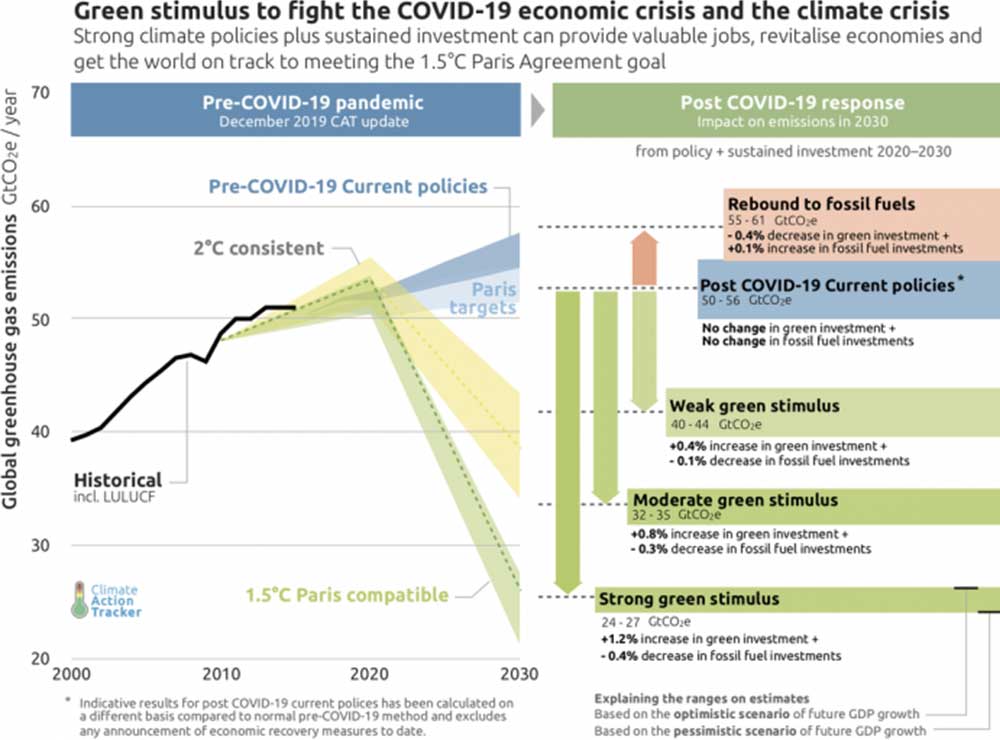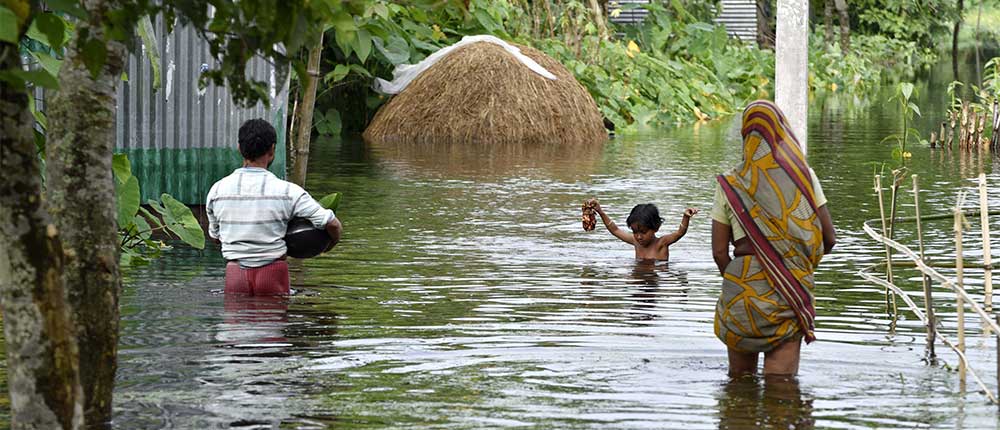The authors take a brief look at the present status of India's climate commitments, the implications of these recovery packages in the post COVID-19 crises, and the road ahead for clean and green development.

The COVID-19 pandemic has tipped the balance of the environment and economies. There is continuous discussion on how the pandemic and the associated lockdown has impacted air quality, emissions and created potential opportunity for biodiversity and wildlife to thrive due to minimal human intervention. Similarly, economic losses due to reduced GDP growth and loss in employment are leading to concerns as to how countries may opt, or would be forced to opt, for solutions that may not be climate or environment friendly. This complex situation warrants the need for countries to examine their progress towards climate commitments and plan for a future that is unpredictable with limited financial resources and prone to physical disruptions due to the pandemic. In order to combat the adverse impacts of the pandemic several governments across the globe have resorted to designing recovery packages to boost demand and investments in particular. Implementing these packages are likely to benefit the economy along with impacting the climate commitments by these countries. On the same lines, the Indian government has announced several recovery packages under various tranches.
Present state of climate commitments in India: Where are we?
India's NDCs have three numeric targets for 2030: Reduce emissions intensity by 33% to 35% from 2005 levels, achieve an installed power capacity of 40% from non-fossil fuel sources, and create an additional carbon sink of 2.5–3.0 GtCO2e from forest and tree cover[1]. India has continued its efforts towards achieving its renewable and intensity targets, though the previous year saw no substantial course change.
India has proactively pursued the mitigation and adaptation activities it committed under the Paris Agreement and has achieved a reduction in emission intensity of GDP by 21% over the period 2005-2014[2]. While there have been criticisms regarding the numbers that have been reported, it is noteworthy that India has achieved such a significant reduction. According to the Climate Action Tracker (CAT)[3], India is compatible with the 2 degrees scenario, but its efforts are still not adequate to be compatible with 1.5 degrees scenario in accordance with the Paris Agreement. The specific climate related commitments by India are summarised below.

Are recovery packages well suited to meet India's climate commitments?
Governments across the globe have announced recovery and stimulus packages to combat the economic crises caused due to the pandmic. This is likely to have a vast impact on the climate commitments of several countries. A recent study by Oxford (2020) analyses the impact of fiscal recovery packages on climate change. As a matter of fact, the climate emergency is similar to COVID-19 emergency, except that the duration of impact and intensity varies considerably. The commonalities in these two emergencies include existence of market failures, international cooperation, complex science, questions of system resilience, political leadership, and action that hinges on public support. The Oxford study mentions that green fiscal recovery packages can act to decouple economic growth and reduce the welfare inequalities exacerbated by the pandemic in the short term and climate change in the long term. Although short term reductions in greenhouse gases (GHG) emissions have been achieved due to lockdown, the reduction will be temporary unless backed by institutional changes. There is still no strict evidence to whether the climate impact induced by the short-term rescue packages has been positive.
An assessment conducted by Climate Action Tracker (CAT)2020 on the post COVID-19 response is illustrated in Figure 1. The study has analysed two economic recovery pathways with five scenarios of responses to the COVID-19 pandemic: fossil fuel rebound, post-COVID current policies, weak green stimulus, moderate green stimulus, and strong green stimulus. The key findings are as below:
- Under the current policy scenario, without any intervention there will hardly be any impact on emissions post COVID-19, it is just that the increase in emissions will be delayed. However, under an optimistic scenario, if the current trends in low carbon energy sector investments are maintained, the global emissions will reduce as illustrated in Figure1.
- Under a fossil fuel rebound scenario, if there is a move back towards fossil fuel technologies, it will result in higher emissions even in the most pessimistic recovery scenario with low economic growth.
- In the third case, the three types of green economic stimulus packages i.e. weak, moderate, and strong green stimulus packages, will necessarily result in emission reduction by 2030. These green stimulus packages emphasise on low to zero carbon green systems.

India has recently announced a series of economic recovery packages to boost various economic sectors such as agriculture, MSMEs and power. It is uncertain as to what will be the future growth trajectory as the Indian government has announced measures to revamp coal based commercial mining and coal gasification, which is likely to have a considerable negative environmental impact. Vivid economics (2020)[4] in a recent study highlights the abysmal performance of India's stimulus package with extent of its greenness[5]. On the contrary, the next generation EU recovery package is likely to have a positive impact on both economic recovery as well as reduced emissions through a host of specifically targeted measures and policies for reducing dependence on fossil fuels.
Many recent studies look into a comparative analysis of greening of recovery measures; however, it would be difficult and challenging to directly compare India with any other European economy in terms of impact of green stimuli on emissions when the state of economy in terms of energy consumption, incomes and Human Development Index (HDI) are not similar.
Although there is no explicit mention of the 'green' component in India's recovery packages, there are calls for a green economy focusing on opportunities in power, transport, agriculture, MSMEs, and urban planning, thereby leveraging on the recovery packages to create additional momentum. The brighter side of the recovery packages is India's increased emphasis on renewable energy development from solar and wind sources. Incentive schemes and financing mechanisms in the form of direct loans and government guarantees are expected to result in increased investments into the sector. With present levels of 23.6% (approx.) of India's installed electricity generation capacity derived from renewable sources, the country is right on track to achieve its committed 40% from RE sources by 2030.
Tackling climate change post pandemic
Obviously, the recent pandemic has thrown unprecedented challenges to the people and economy and has adversely affected the economic growth of countries across the globe including India. As a consequence, GHG emissions from fossil fuels and industry is anticipated to fall in 2020 by at least 4-11% and possibly also in 2021 by 1% above to 9% below 2019 levels. However, this reduced emission is due to downturn of economic activity and not due to any real technological innovation. While the global economy was pursuing the climate commitments prior to the pandemic, the changed circumstances compel us to think whether the climate commitments and sustainability agenda fit into the immediate concerns. However, analysts believe that not only do climate concerns remain critical over the long term but investments in climate resilient infrastructure and the subsequent transition to a low carbon future can indeed lead to job creation and economic resilience (McKinsey 2020)[6]. In fact, there exists a broader interrelationship between climate and pandemic risks through the multiplied risk impacts of climate change and a potential pandemic. Hence the moot question relates to finding an integrated approach to address both environmental and economic sustainability.
Need for better and resilient climate systems
With the rise of COVID-19, the inter relationship between climate change and global pandemic has become a major discussion with research indicating that spread of diseases would be faster due to the rise in temperatures. The rise of COVID-19 has warranted the need to enforce measures such as social distancing norms and avoidance of travel which has had a crippling ripple effect across sectors and countries. Since the outbreak, several major climate disasters have already occurred including heatwaves, typhoons, cyclones, bushfires, and locust attacks, among others. Such climate disasters exacerbate the stress of the pandemic and create additional pressures for governments across the world to undertake actions to manage them.

With the National Disaster Management Authority (NDMA) taking the lead in COVID-19 response in India, the authority is also charged with initiating emergency response for heatwaves, cyclones and floods[7]. With the healthcare system already under stress due to the pandemic, the dual impact of climate related disasters accentuates the vulnerabilities. A case in point is Cyclone Amphan that required dual efforts from Bangladesh and India to address the challenges emerging from the natural disaster while tackling the spread of the pandemic[8]. Additionally, many cyclone-affected areas also witnessed the return of migrants due to COVID-19, generating strong resistance among locals. Such sociological stresses also pose economic effects that would exacerbate the existing stressors[9] (Indian Express, 2020).
The role of climate resilient systems is pertinent and necessary to ensure that uncalled-for stress on health and disaster management infrastructure is reduced or eliminated. The recovery packages announced globally need to take into consideration that such natural disasters would continue to occur in the current climate scenario, hence every plan and investment needs to be envisaged with adaptive capacity and resilience to such further shocks. With constrained public budgets and stretched workforce, recovery packages should focus on climate resilient investment opportunities that reduce the existing stress and strengthen systems and infrastructure as a preventive measure for the future.
Strengthening international cooperation for fulfilling climate commitments
With UN Biodiversity Conference (COP15) and COP26 Conference on climate change both being postponed to 2021, concerns about countries lagging behind in their climate commitments have been continuously raised since the pandemic began raging. Hence, the need to reiterate commitment to addressing climate change is necessary to ensure continuity till 2021. The UN Intergovernmental Conference on Marine Biodiversity of Areas Beyond National Jurisdiction should have delivered a draft text in April 2020, also stands postponed. IUCN's scheduled World Conservation Congress in June stands postponed as well, raising concerns that biodiversity as an issue could get neglected in the current pandemic. The pandemic clearly reflects the intrinsic relationship between biodiversity and spread of diseases. The origin of the disease due to animal-human interaction is one aspect that should be taken into consideration to ensure biodiversity conservation and reduce human interference in fragile biodiverse regions.
The year 2020 was hailed as a landmark year that kickstarted the journey to Agenda 2030, possibilities of raising ambitions at the CoP and the formulation of biodiversity policy framework that would take forward and replace the Aichi biodiversity targets. All of these milestones have been shifted to 2021 and the question of what would the global economy look like in 2021 and what would be its impacts on the ongoing negotiations needs to be answered to formulate strategies to remain on track.
Leveraging recovery packages for clean and green development
The implementation of recovery packages could be planned and designed to contribute to clean and green development investments into establishing green projects that generate jobs and ensure continuance to achieve climate commitments. Recovery packages have already been announced in certain countries and several initiatives are being initiated to address the short-term needs to affected populace, however the existing recovery packages should be well implemented and opportunities need to be identified to address green investments and sustainable policies.
The energy sector specifically the consumption of energy commodities has experienced a sharp decline, however this would improve as countries recover from COVID-19. However, the pandemic provides an opportunity to leverage on the digitalisation of energy infrastructures and systems especially for daily operations. It would be beneficial to examine mechanisms that could enable remote operations a reality in the energy sector to ensure uninterrupted services. Digitalisation could also enhance efficiency in operations, maintenance and provision of services.

Despite its low per capita emissions, India has made significant commitments in its NDC submitted to the United Nations Framework Convention on Climate Change (UNFCCC) in 2015 as part of the Paris Agreement. However, India's' journey to achieving its commitments is still long. India has proactively pursued mitigation and adaptation activities and has achieved emission reductions, however, to meet the Paris commitments and fully implement the NDCs in a timely manner, India needs to effectively assess the gaps in existing financing sources and simultaneously evaluate the effectiveness of technological l and capacity building efforts. In terms of financing, some of the additional sources of funds announced by the Indian government in the post COVID recovery packages include guarantee fund for MSMEs, Agriculture Infrastructure Fund for farm-gate infrastructure, funds for Cold Chain infrastructure development, waste management and resource efficiency.
These will provide additional finance According to the recently released report of the Sub- Committee for the Assessment of the Financial Requirements for Implementing (NDCs[10]in the Ministry of Finance highlights the significant financial resources India would require to continue and sustain its climate action. The report states, “the preliminary financial estimates in NDC document indicate that India would need around US$ 206 billion (at 2014-15 prices) between 2015 and 2030 for implementing adaptation actions in key areas like agriculture, forestry, fisheries infrastructure, water resources and ecosystems. Apart from this, there will be additional investments needed for strengthening resilience and disaster management". India needs significant financial resources to address climate change goals and more so during the COVID 19 pandemic to ensure continuity and progress. New and additional financial and technological support to the developing countries is committed by the Paris Agreement which now needs to be operationalised.
Concluding remarks
COVID 19 has created roadblocks with short term and long-term implications for the Indian economy, society and the world at large. While it is acknowledged that both the pandemic and climate crises are emergencies which need to be addressed simultaneously, the severity and intensity of the impacts vary. Accordingly, the recovery packages announced by governments to address the impacts also vary in nature, coverage and scale. According to CAT (2020). although the growth in emissions is in line with both the 2020 and 2030 intensity pledges, the achievement of India's targets depends on actual economic growth levels, which are expected to be considerably lower due to the pandemic. While it is felt that some of the recovery measures announced in India, especially in the agriculture, MSME and waste management sectors, have potential to be green, their major orientation at the moment is towards ensuring livelihoods and restarting economic activities in organised and unorganised sectors of rural and urban India.
Simultaneous handling of long-term climate change impacts and long-lasting public health crises created by COVID-19 while maintaining the growth trajectory is a new challenge for most economies, and more so for the developing countries like India whose resources are limited. All countries including India need to enhance cooperation in order to confront climate change and COVID-19 at the same time, as “the climate emergency is like the COVID-19 emergency, just in slow motion and much graver"[11]. As COVID challenge is likely to stay for quite some time with most countries, it is imperative that they look for windows of opportunities in the existing and future packages to take greener actions rather than attempting to redesign the recovery packages themselves.
* The Authors are immensely thankful to Mr R R Rashmi, Programme Director, Integrated Policy Analysis Division for his valuable insights and inputs.
Footnotes:
[1] https://pib.gov.in/newsite/PrintRelease.aspx?relid=128403
[2] MOEFCC (2018). India Second Biennial Update Report to the United Nations Framework Convention on Climate Change.
[3] CAT (2020). A government roadmap for addressing the climate and post COVID-19 economic crises.
[4] Vivid Economics (2020). Green Stimulus Index.
[5] Terminology used in the paper by Vivid economics (2020), the extent of greenness is defined by the total fiscal spending in response to COVID categorised as having either a positive (green) or negative (brown) impact on the environment
[6] McKinsey (2020). Addressing climate change in a post-pandemic world.
[7] Building Climate resilience in extreme heat during COVID 19, April 23, 2020
[8] Coronavirus makes investing in climate adaptation more urgent than ever, June 10, 2020
[9] Covid, cyclone, lockdown: All lines blur in Sundarbans May 31, 2020
[10] Sub-Committee for the Assessment of the Financial Requirements for Implementing India's Nationally Determined Contribution (NDC), June 2020
[11] Hepburn, C., O'Callaghan, B., Stern, N., Stiglitz, J., and Zenghelis, D. (2020), 'Will COVID-19 fiscal recovery packages accelerate or retard progress on climate change?', Smith School Working Paper 20-02.
